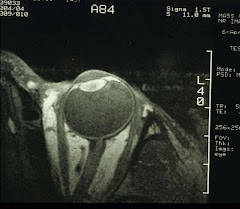 Guo Jingjing is the Gold medalist of Women's 3-m springboard diving of the 2008 Olympics. She took up diving since age 7. And now at age 27, she is the most decorated Olympic female diver ever.
Guo Jingjing is the Gold medalist of Women's 3-m springboard diving of the 2008 Olympics. She took up diving since age 7. And now at age 27, she is the most decorated Olympic female diver ever.And the price she has paid as far as the eyes? Retinal tears or breaks:
 They lead up to the more severe sight-threatening retinal detachment. Which was probably what has happened to Ms Guo. In 2002, a retinal break was discovered in her right eye. After a successful surgical repair, her vision or visual field dropped to 20% of normal anyway. In 2004, right before the Olympics in Athens, the retina apparently has re-detached. She went on to win two gold medals nonetheless. After the 2008 Games, both eyes now require surgery.
They lead up to the more severe sight-threatening retinal detachment. Which was probably what has happened to Ms Guo. In 2002, a retinal break was discovered in her right eye. After a successful surgical repair, her vision or visual field dropped to 20% of normal anyway. In 2004, right before the Olympics in Athens, the retina apparently has re-detached. She went on to win two gold medals nonetheless. After the 2008 Games, both eyes now require surgery.Sudden physical impacts or blunt trauma to the eyes in, e.g., boxing, car accidents, baseball or hockey games, can disrupt the retinal (and sometimes choroidal) structure. Even if there is no detectable blow-out detachment when the eyes are examined immediately after the injury, it does not mean that the patient is out of the woods. Unfortunately, the latency for retinal detachment is quite long, often in years. Diving apparently involves repetitive impacts on the top portion of the eye. In other words, when the diver's head enters the pool water, the contact force will have been transmitted to the eyeballs. And the latency of retinal detachment will have been considerably shortened. Even worse if there are other pre-disposing factors, e.g., high myopia and/or family history of retinal detachment.
Athletes in competitive diving should probably have their retinas examined at least once every 6 months.










